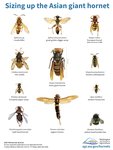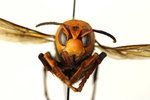

Wondering just how big the invasive Asian giant hornet is compared to a honeybee, bumblebee or paper wasp? The state Department of Agriculture has released a chart to help you.
"We've had lots of questions about how Asian giant hornets compare in size to other similar-looking insects. Check out our new to-scale size comparison to see," the agency posted on its Facebook page on Wednesday, April 29.
In December 2019, the state department received and verified four reports of Asian giant hornets near Blaine and Bellingham. They were the first sightings of the hornets in Washington state and the U.S.
Members of the Mt. Baker Beekeepers Association have put up traps and are monitoring them as part of the state's efforts to find and kill the invasive pests so they don't reproduce and becoming established in Washington.
State officials also are asking for the public's help in reporting any possible sightings of an Asian giant hornet as well as making and hanging bottle traps in summer.
The hornets are known for their painful stings and voracious appetite for honeybees, which concerns beekeepers and agriculture officials.
The size comparison chart provided by the state shows an Asian giant hornet that's 4 centimeters long, or roughly 1-1/2 inches.
It dwarfs all the other winged insects near it, making the yellow head bumblebee, bald-faced hornet and western yellow jacket -- which are familiar to Washington state residents -- seem small by comparison, even the burly bumblebee.
And it's size compared to the Western honeybee is straight-up Goliath vs. David.
About the size of an adult thumb, the Asian giant hornet, or Vespa mandarinia, is the world's largest hornet. Its stinger is longer than a typical, native wasp, so each sting delivers more venom.
They are identifiable by their large heads, which are yellow/orange.
Their native range is Asia.
Asian giant hornets are typically dormant during winter. They're seen usually from July through October.
The Washington State Department of Health recommends the following steps for staying safe and for what to do if you're stung.
-- Protect yourself while outside by keeping food and drinks covered and dispose of food and garbage properly.
-- Don't swat at the hornets because that might make them sting.
-- If you're stung, thoroughly wash the area with soap and water.
-- Reduce swelling by applying ice or a cold compress. Applying ice also will slow the spread of the venom. There won't be a stinger for you to pull out.
-- Take an antihistamine or use anti-itch cream to reduce itching.
-- If you are stung multiple times or have a severe reaction, such as trouble breathing or difficulty swallowing, after being stung, call 911 or get medical care immediately.
Report it
If you think you've seen an Asian giant hornet, the Washington State Department of Agriculture wants you to report it. Here's how:
-- Go online to the Hornet Watch Report Form.
-- Email PestProgram@agr.wa.gov.
-- Call 1-800-443-6684.
Stay updated at the Asian giant hornet watch Facebook group.
Learn more at agr.wa.gov/hornets, including how to make bottle traps for Asian giant hornets.